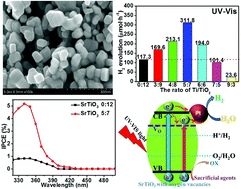Constructing bulk defective perovskite SrTiO3 nanocubes for high performance photocatalysts†
Abstract
Defects (Ti3+ or oxygen vacancies) have been demonstrated to promote the charge separation process in TiO2 based photocatalysts. Particularly, the bulk defects within a certain concentration can give a great enhancement for both light absorption and charge separation efficiency. In this report, we explored a one-step molten salts route to synthesize SrTiO3 nanocubes with bulk defects (Ti3+ doped) by using SrCO3 as a Sr source, and TiO2 and Ti powder as Ti sources. The amount of defects can be tuned by changing the molar ratio of Ti/TiO2. The corresponding bandgap of SrTiO3 can be changed from 3.29 to 2.73 eV with the increase of defects. X-ray diffraction and electron microscopy disclose that SrTiO3 is highly crystalline and has a cubic morphology. X-ray photoelectron spectroscopy and electron paramagnetic resonance indicate that the as-prepared SrTiO3 is close to the Ti3+ doped SrTiO3. Surface photovoltage spectroscopy (SPS) and field-induced SPS confirm that Ti3+ doping in the SrTiO3 turns it from an n-type semiconductor to p-type. The SrTiO3 with an optimal amount of defects exhibits highly enhanced photocatalytic performance. An excess amount of defects results in a weak SPS response and photocatalytic performance.


 Please wait while we load your content...
Please wait while we load your content...